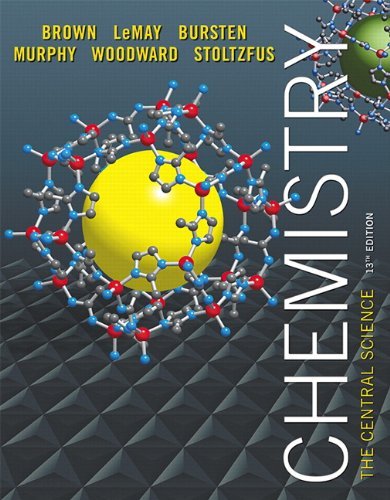Chemistry The Central Science Brown 13th Edition Test Bank
$35.00 Original price was: $35.00.$26.50Current price is: $26.50.
Chemistry The Central Science Brown 13th Edition Test Bank
This is completed downloadable of Chemistry The Central Science Brown 13th Edition Test Bank
Product Details:
- ISBN-10 : 0321910419
- ISBN-13 : 978-0321910417
- Author: Theodore E. Brown (Author), H. Eugene LeMay (Author), Bruce E. Bursten (Author), Catherine Murphy (Author), Patrick Woodward (Author), Matthew E. Stoltzfus (Author)
Unrivaled problems, notable scientific accuracy and currency, and remarkable clarity have made Chemistry: The Central Science the leading general chemistry text for more than a decade. Trusted, innovative, and calibrated, the text increases conceptual understanding and student success in general chemistry by building on the expertise of the dynamic author team of leading researchers and award-winning professors.
The new Thirteenth Edition builds on the Twelfth Edition’s major revision, in which every word and piece of art was scrutinized by all the authors to increase its effectiveness. Placing a greater emphasis on research, this edition is more tightly integrated with MasteringChemistry, the leading online homework, tutorial, and assessment program— resulting in an unparalleled teaching and learning package that personalizes learning and coaches students toward understanding and mastery of tough chemistry topics.
Table of Content:
-
1: Introduction – Matter and Measurement
- 1.1: Studying Chemistry
- 1.2: Classification of Matter
- 1.3: Properties of Matter
- 1.4: Units of Measurement
- 1.5: Uncertainty in Measurement
- 1.6: Dimensional Analysis
- 1.E: Matter and Measurement (Exercises)
- 1.S: Matter and Measurement (Summary)
-
2: Atoms, Molecules, and Ions
- 2.1: The Atomic Theory of Matter
- 2.2: The Discovery of Atomic Structure
- 2.3: The Modern View of Atomic Structure
- 2.4: Atomic Mass
- 2.5: The Periodic Table
- 2.6: Molecules and Molecular Compounds
- 2.7: Ions and Ionic Compounds
- 2.8: Naming Inorganic Compounds
- 2.9: Some Simple Organic Compounds
- 2.E: Atoms, Molecules, and Ions (Exercises)
- 2.S: Atoms, Molecules, and Ions (Summary)
-
3: Stoichiometry- Chemical Formulas and Equations
- 3.1: Chemical Equations
- 3.2: Some Simple Patterns of Chemical Reactivity
- 3.3: Formula Masses
- 3.4: Avogadro’s Number and the Mole
- 3.5: Empirical Formulas from Analysis
- 3.6: Quantitative Information from Balanced Equations
- 3.7: Limiting Reactants
- 3.E: Stoichiometry (Exercises)
- 3.S: Stoichiometry (Summary)
-
4: Reactions in Aqueous Solution
- 4.1: General Properties of Aqueous Solutions
- 4.2: Precipitation Reactions
- 4.3: Acid-Base Reactions
- 4.4: Oxidation-Reduction Reactions
- 4.5: Concentration of Solutions
- 4.6: Solution Stoichiometry and Chemical Analysis
- 4.E: Reactions in Aqueous Solution (Exercises)
- 4.S: Reactions in Aqueous Solution (Summary)
-
5: Thermochemistry
- 5.1: The Nature of Energy
- 5.2: The First Law of Thermodynamics
- 5.3: Enthalpy
- 5.4: Enthalpy of Reaction
- 5.5: Calorimetry
- 5.6: Hess’s Law
- 5.7: Enthalpies of Formation
- 5.8: Foods and Fuels
- 5.E: Thermochemistry (Exercises)
- 5.S: Thermochemistry (Summary)
-
6: Electronic Structure of Atoms
- 6.1: The Wave Nature of Light
- 6.2: Quantized Energy and Photons
- 6.3: Line Spectra and the Bohr Model
- 6.4: The Wave Behavior of Matter
- 6.5: Quantum Mechanics and Atomic Orbitals
- 6.6: 3D Representation of Orbitals
- 6.7: Many-Electron Atoms
- 6.8: Electron Configurations
- 6.9: Electron Configurations and the Periodic Table
- 6.E: Electronic Structure of Atoms (Exercises)
- 6.S: Electronic Structure of Atoms (Summary)
-
7: Periodic Properties of the Elements
- 7.1: Development of the Periodic Table
- 7.2: Shielding and Effective Nuclear Charge
- 7.3: Sizes of Atoms and Ions
- 7.4: Ionization Energy
- 7.5: Electron Affinities
- 7.6: Metals, Nonmetals, and Metalloids
- 7.7: Group Trends for the Active Metals
- 7.8: Group Trends for Selected Nonmetals
- 7.E: Periodic Properties of the Elements (Exercises)
- 7.S: Periodic Properties of the Elements (Summary)
-
8: Basic Concepts of Chemical Bonding
- 8.1: Chemical Bonds, Lewis Symbols, and the Octet Rule
- 8.2: Ionic Bonding
- 8.3: Covalent Bonding
- 8.4: Bond Polarity and Electronegativity
- 8.5: Drawing Lewis Structures
- 8.6: Resonance Structures
- 8.7: Exceptions to the Octet Rule
- 8.8: Strength of Covalent Bonds
- 8.E: Basic Concepts of Chemical Bonding (Exercises)
- 8.S: Basic Concepts of Chemical Bonding (Summary)
-
9: Molecular Geometry and Bonding Theories
- 9.1: Molecular Shapes
- 9.2: The VSEPR Model
- 9.3: Molecular Shape and Molecular Polarity
- 9.4: Covalent Bonding and Orbital Overlap
- 9.5: Hybrid Orbitals
- 9.6: Multiple Bonds
- 9.7: Molecular Orbitals
- 9.8: Second-Row Diatomic Molecules
- 9.E: Exercises
- 9.S: Molecular Geometry and Bonding Theories (Summary)
-
10: Gases
- 10.1: Characteristics of Gases
- 10.2: Pressure
- 10.3: The Gas Laws
- 10.4: The Ideal Gas Equation
- 10.5: Further Applications of the Ideal-Gas Equations
- 10.6: Gas Mixtures and Partial Pressures
- 10.7: Kinetic-Molecular Theory
- 10.8: Molecular Effusion and Diffusion
- 10.9: Real Gases – Deviations from Ideal Behavior
- 10.E: Exercises
- 10.S: Gases (Summary)
-
11: Liquids and Intermolecular Forces
- 11.1: A Molecular Comparison of Gases, Liquids, and Solids
- 11.2: Intermolecular Forces
- 11.3: Some Properties of Liquids
- 11.4: Phase Changes
- 11.5: Vapor Pressure
- 11.6: Phase Diagrams
- 11.7: Structure of Solids
- 11.8: Bonding in Solids
- 11.E: Liquids and Intermolecular Forces (Exercises)
- 11.S: Liquids and Intermolecular Forces (Summary)
-
12: Solids and Modern Materials
- 12.1: Classes of Materials
- 12.2: Materials for Structure
- 12.2.1: Concrete
- 12.2.2: Steel
- 12.2.3: Aluminum
- 12.2.4: Polymers
- 12.3: Materials for Medicine
- 12.3.1: Anti-Cancer Drugs I
- 12.3.2: Anti-Cancer Drugs II
- 12.3.3: Antidepressants
- 12.3.4: Barbiturates and Benzodiazepines
- 12.3.5: Drugs Acting Upon the Central Nervous System
- 12.3.6: Hallucinogenic Drugs
- 12.3.7: Local Anesthetics
- 12.3.8: Misc Antibiotics
- 12.3.9: Narcotic Analgesic Drugs
- 12.3.10: Penicillin
- 12.3.11: Sulfa Drugs
- 12.4: Materials for Electronics
- 12.4.1: Bonding in Electronic Materials
- 12.4.2: Silicon Devices
- 12.5: Materials for Optics
- 12.6: Materials for Nanotechnology
-
13: Properties of Solutions
- 13.1: The Solution Process
- 13.2: Saturated Solutions and Solubility
- 13.3: Factors Affecting Solubility
- 13.4: Ways of Expressing Concentration
- 13.5: Colligative Properties
- 13.6: Colloids
- 13.E: Properties of Solutions (Exercises)
- 13.S: Properties of Solutions (Summary)
-
14: Chemical Kinetics
- 14.1: Factors that Affect Reaction Rates
- 14.2: Reaction Rates
- 14.3: Concentration and Rates (Differential Rate Laws)
- 14.4: The Change of Concentration with Time (Integrated Rate Laws)
- 14.5: Temperature and Rate
- 14.6: Reaction Mechanisms
- 14.7: Catalysis
- 14.E: Exercises
- 14.S: Chemical Kinetics (Summary)
-
15: Chemical Equilibrium
- 15.1: The Concept of Equilibrium
- 15.2: The Equilibrium Constant
- 15.3: Interpreting and Working with Equilibrium Constants
- 15.4: Heterogeneous Equilibria
- 15.5: Calculating Equilibrium Constants
- 15.6: Applications of Equilibrium Constants
- 15.7: Le Chatelier’s Principle
- 15.E: Exercises
- 15.S: Chemical Equilibrium (Summary)
-
16: Acid–Base Equilibria
- 16.1: Acids and Bases – A Brief Review
- 16.2: Brønsted–Lowry Acids and Bases
- 16.3: The Autoionization of Water
- 16.4: The pH Scale
- 16.5: Strong Acids and Bases
- 16.6: Weak Acids
- 16.7: Weak Bases
- 16.8: Relationship Between Ka and Kb
- 16.9: Acid-Base Properties of Salt Solutions
- 16.10: Acid-Base Behavior and Chemical Structure
- 16.11: Lewis Acids and Bases
- 16.E: Acid–Base Equilibria (Exercises)
- 16.S: Acid–Base Equilibria (Summary)
-
17: Additional Aspects of Aqueous Equilibria
- 17.1: The Common-Ion Effect
- 17.2: Buffered Solutions
- 17.3: Acid-Base Titrations
- 17.4: Solubility Equilibria
- 17.5: Factors that Affect Solubility
- 17.6: Precipitation and Separation of Ions
- 17.7: Qualitative Analysis for Metallic Elements
- 17.E: Additional Aspects of Aqueous Equilibria (Exercises)
- 17.S: Additional Aspects of Aqueous Equilibria (Summary)
-
18: Chemistry of the Environment
- 18.1: Earth’s Atmosphere
- 18.2: Outer Regions of the Atmosphere
- 18.3: Ozone in the Upper Atmostphere
- 18.4: Chemistry of the Troposphere
- 18.5: The World Ocean
- 18.6: Fresh Water
- 18.7: Green Chemistry
- 18.E: Chemistry of the Environment (Exercises)
-
19: Chemical Thermodynamics
- 19.1: Spontaneous Processes
- 19.2: Entropy and the Second Law of Thermodynamics
- 19.3: The Molecular Interpretation of Entropy
- 19.4: Entropy Changes in Chemical Reactions
- 19.5: Gibbs Free Energy
- 19.6: Free Energy and Temperature
- 19.7: Free Energy and the Equilibrium Constant
- 19.E: Chemical Thermodynamics (Exercises)
-
20: Electrochemistry
- 20.1: Oxidation States and Redox Reactions
- 20.2: Balanced Oxidation-Reduction Equations
- 20.3: Voltaic Cells
- 20.4: Cell Potential Under Standard Conditions
- 20.5: Gibbs Energy and Redox Reactions
- 20.6: Cell Potential Under Nonstandard Conditions
- 20.7: Batteries and Fuel Cells
- 20.8: Corrosion
- 20.9: Electrolysis
- 20.E: Electrochemistry (Exercises)
-
21: Nuclear Chemistry
- 21.1: Radioactivity
- 21.2: Patterns of Nuclear Stability
- 21.3: Nuclear Transmutations
- 21.4: Rates of Radioactive Decay
- 21.5: Energy Changes in Nuclear Reactions
- 21.6: Nuclear Fission
- 21.7: Nuclear Fusion
- 21.8: Biological Effects of Radiation
- 21.E: Exercises
- 21.S: Nuclear Chemistry (Summary)
-
22: Chemistry of the Nonmetals
- 22.1: General Concepts- Periodic Trends and Reactions
- 22.2: Hydrogen
- 22.3: Group 18- Noble Gases
- 22.4: Group 17- The Halogens
- 22.5: Oxygen
- 22.6: The Other Group 16 Elements- S, Se, Te, and Po
- 22.7: Nitrogen
- 22.8: The Other Group 15 Elements – P, AS, Sb, and Bi
- 22.9: Carbon
- 22.10: The Other Group 14 Elements- Si, Ge, Sn, and Pb
- 22.11: Boron
- 22.E: Chemistry of the Nonmetals (Exercises)
- 22.S: Chemistry of the Nonmetals (Summary)
-
23: Chemistry of Coordination Chemistry
- 23.1: Metal Complexes
- 23.2: Ligands with more than one Donor Atom
- 23.3: Nomenclature of Coordination Chemistry
- 23.4: Isomerization
- 23.5: Color and Magnetism
- 23.6: Crystal Field Theory
- 23.E: Chemistry of Coordination Chemistry (Exercises)
-
24: Chemistry of Life- Organic and Biological Chemistry
- 24.1: General Characteristics of Organic Molecules
- 24.2: Introduction to Hydrocarbons
- 24.3: Alkanes
- 24.4: Unsaturated Hydrocarbons
- 24.5: Functional Groups
- 24.6: Compounds with a Carbonyl Group
- 24.7: Chirality in Organic Chemistry
- 24.8: Introduction to Biochemistry
- 24.9: Proteins
- 24.10: Carbohydrates
- 24.11: Nucleic Acids
- 24.E: Organic and Biological Chemistry (Exercises)
- 24.S: Organic and Biological Chemistry (Summary)
-
Index
-
Glossary
-
Detailed Licensing
People Also Search:
chemistry the central science brown 13th edition
chemistry the central science brown
chemistry the central science brown 13th edition testbank download pdf
chemistry the central science brown 13th edition download scribd
Related products
Test Bank
Test Bank for Operating Systems: Internals and Design Principles, 7th Edition: William Stallings
Test Bank
Test Bank for Clinical Immunology and Serology A Laboratory Perspective, 3rd Edition: Stevens












